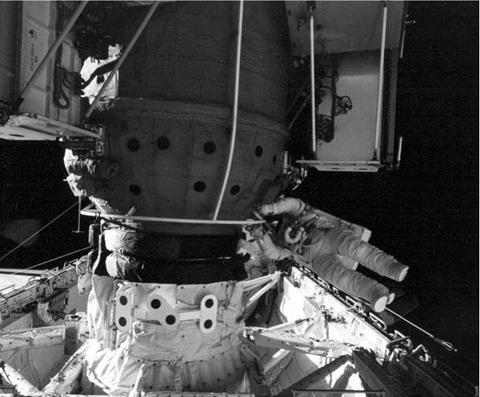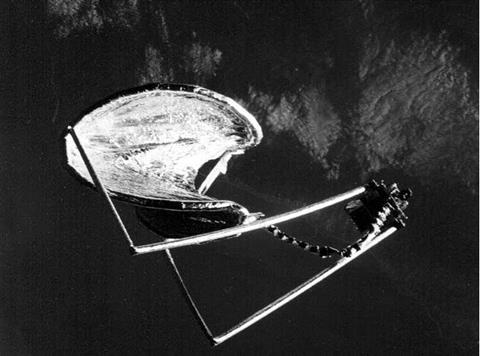STS-76
|
Int. Designation |
1996-018A |
|
Launched |
22 March 1996 |
|
Launch Site |
Pad 39B, Kennedy Space Center, Florida |
|
Landed |
31 March 1996 |
|
Landing Site |
Runway 22, Edwards AFB, California |
|
Launch Vehicle |
OV-104 Atlantis/ET-77/SRB BI-079/SSME #1 2035; #2 2109; #3 2019 |
|
Duration |
9 days 5 hrs 15 min 53 sec Lucid 188 days 4hrs 0min 11 sec (landed on STS-79) |
|
Call sign |
Atlantis |
|
Objective |
Third Shuttle-Mir docking mission; transfer of NASA-2 astronaut (Lucid) to Mir EO-21 resident crew |
Flight Crew
CHILTON, Kevin Patrick, 41, USAF, commander, 3rd mission Previous missions: STS-49 (1992); STS-59 (1994)
SEARFOSS, Richard A., 39, USAF, pilot, 2nd mission Previous mission: STS-58 (1993)
SEGA, Ronald Michael, 43, civilian, mission specialist 1, 2nd mission Previous mission: STS-60 (1994)
CLIFFORD, Michael Richard Uram, 43, US Army, mission specialist 2, 3rd mission
Previous missions: STS-53 (1992); STS-59 (1994)
GODWIN, Linda Maxine, 43, civilian, mission specialist 3, 3rd mission Previous missions: STS-37 (1991); STS-59 (1994)
NASA-2 up only:
LUCID, Shannon Wells, 53, civilian, mission specialist 4, EO-21 research cosmonaut, NASA-2 board engineer, 5th mission
Previous missions: STS 51-G (1985); STS-34 (1989); STS-43 (1991); STS-58 (1993)
Flight Log
Lessons were learned from Thagard’s stay on Mir. Missing his family was one of the main problems he identified, so NASA organised regular contact for subsequent NASA astronauts who stayed on Mir. Thagard was thankful that he did not have to endure an extended mission of six months, but Shannon Lucid was forced to do exactly that. The O-rings from the retrieved SRBs on STS-75 showed a different problem from that seen on STS-71 and 70. This time, the gas path went through the
|
Clifford is seen during the 27 March EVA at the restraint bar on the Docking Module of Mir. Godwin is out of frame. During the EVA, both astronauts were careful not to venture beyond the 4.6 DM onto Kristall, due to Russian fears of accidental damage. NASA would have similar concerns if cosmonauts inadvertently ventured from Mir across to an unfamiliar Shuttle during a future EVA |
adhesive but not past it. This had been seen before, but never with two different gas paths on both motors. A review deemed that the STS-76 units would be safe to fly, but the 21 March attempt was scrubbed due to concerns over high winds. The revised launch occurred without further difficulty, but APU 3 shut down prior to entering orbit. Mission management concluded that the system would remain stable, however, and would still support a full-duration mission.
The docking with Mir occurred on FD 3, and for the next five days the astronauts worked with the EO-21 cosmonauts to transfer 680 kg of water to the station in fifteen Contingency Water Containers (CWC). Two tons of equipment were also transferred into Mir, while experiment samples and unwanted equipment were taken back into Atlantis for the return to Earth. Lucid transferred to the Mir resident crew two hours after the hatches were opened following docking. She relocated her personal Soyuz seat support into the Descent Module of Soyuz TM23. Also transferred over to the
space station were Mir Glove Box stowage experiments, which were located in the station’s Docking Module. While docked, the Shuttle crew activated or worked on a number of secondary experiments located in the Shuttle’s middeck, SpaceHab module and payload bay.
On FD 6, Godwin (EV1) and Clifford (EV2) performed the first US EVA at a space station since the final Skylab EVA in February 1973. This was also the first time that activities were performed around the docking interfaces of two different spacecraft since Apollo 9 in March 1969. Godwin and Clifford attached four Mir Environmental Effects Payload (MEEP) experiments to the station’s Docking Module. Over an 18-month period, these experiments were designed to examine the environment around the station. Both astronauts wore a SAFER unit (first tested on STS-64) during an EVA which lasted 6 hours 2 minutes.
Undocking occurred on FD 8, leaving Lucid aboard Mir at the start of a planned two-year continuous American presence on the station by successive astronauts. The landing of STS-76 was planned for 31 March, but was brought forward due to anticipated rain and clouds around the Cape area. In the event, both the 30 and 31 March attempts were waived off due to the bad weather and Atlantis was eventually diverted to Edwards. Following the problem with APU 3 during ascent, extra precautions were instigated for the landing, particularly in requiring more conservative weather criteria. After the 30 March waive-off, the re-opening of the payload bay doors to expose the orbiter’s radiators was interrupted by indications that latches 9-12 on both sides had failed to open properly. A visual inspection from SpaceHab confirmed that they had operated correctly, however, and it was determined that faulty micro-switches had given erroneous indications of problems. The doors closed nominally for landing. Despite the loss of three of the primary RCS thrusters out of the set of 38, the re-entry of STS-76 was not adversely affected.
Milestones
188th manned space flight
106th US manned space flight
76th Shuttle mission
16th flight of Atlantis
3rd Shuttle-Mir docking mission
34th US and 62nd flight with EVA operations
4th SpaceHab mission (4th single module)
1st SpaceHab space station mission
1st US EVA at a space station for 22 years

 |
Flight Crew
CASPER, John Howard, 52, USAF, commander, 4th mission Previous missions: STS-36 (1990); STS-54 (1993); STS-62 (1994) BROWN Jr., Curtis Lee, 40, USAF, pilot, 3rd mission Previous missions: STS-47 (1992); STS-66 (1994)
THOMAS, Andrew Sydney Withiel, 44, civilian, mission specialist 1 BURSCH, Daniel Wheeler, 38, USN, mission specialist 2, 3rd mission Previous missions: STS-51 (1993); STS-68 (1994)
RUNCO Jr., Mario, 44, civilian, mission specialist 3, 3rd mission Previous missions: STS-44 (1991); STS-54 (1993)
GARNEAU, Marc Joseph Jean-Pierre, 47, civilian, Canadian mission specialist 4, 2nd mission Previous mission: STS 41-G (1984)
Flight Log
After rescheduling the original 16 May launch date due to other programmes at the Eastern Test Range of the Cape, STS-77 was launched on time three days later. This mission featured four rendezvous activities with two different payloads. The largest payload was the SpaceHab 4 module, with a mass of about 1,300 kg of experiments and support equipment. Its research programme encompassed twelve commercial space product development packages in biotechnology, polymers and agriculture, and electronic materials. Over 90 per cent of the payloads on the mission were sponsored by NASA’s Office of Space Access and Technology (OSAT). In addition to SpaceHab 4, Endeavour’s cargo included the SPARTAN-207 free-flyer carrier, from which the Inflatable Antenna Experiment would be deployed, and a suite of four technology experiments, designated TEAMS, in the payload bay. One of these was a cooperative experiment between the US, Canada and Germany, in which
|
The Inflatable Antenna Experiment (IAE), part of the SPARTAN 207 payload, nears completion of its inflation process. The IAE experiments provided further groundwork for future technology development in inflatable space structures, which will be launched and then inflated like a balloon on orbit |
various samples of electronic and semi-conductor material were heated using float zone techniques, designed to produced large, ultra-pure crystals of semi-conductor materials such as gallium arsenide.
On FD 2, SPARTAN-207 was deployed using the RMS. Attached to the SPARTAN was the 60 kg IAE structure, mounted on three struts, which was inflated to its full size of about 15 metres in diameter. After 90 minutes, the structure was ejected, allowing the SPARTAN to be retrieved later in the mission. The objective of the inflation experiment was to gather data about its on-orbit behaviour by recording the deployment and inflation sequence on film. This would provide designers with important information for the design of future deployable and inflatable structures in space. The potential benefits of such structures include lower development costs, lower mass and volume inside launch vehicles, and the possibility of utilising a smaller launch vehicle to get them into orbit.
Other deployment and rendezvous activities on the fourth day of the mission included the release of the Passively Aerodynamically-stabilised Magnetically – damped Satellite (PAMS), one of four Technology Experiments for Advancing Missions in Space (or TEAMS) that were mounted on a hitchhiker carrier in the payload bay of the orbiter. The other TEAMS experiments included a GPS attitude and navigation experiment, a Vented Tank Re-supply Experiment and a Liquid Mass Thermal Experiment. There was also a range of secondary payloads in technology and biology, and further GAS canisters on the flight. The Aquatic Research Facility was a joint NASA/Canadian experiment for investigating a wide range of small aquatic species. For this mission, it included starfish, muscles and sea urchins, and it was hoped that the facility would provide scientists with the opportunity to investigate the process of fertilisation, formation of embryos and development of calcified tissue, as well as the feeding behaviour of small aquatic organisms while in the microgravity environment.
Commander Casper took the opportunity to talk with Shannon Lucid on her 65th day on Mir during the mission. In addition to a smooth, on-time launch, Endeavour showed no significant on-orbit problems and completed a first opportunity landing at Edwards, the smoothest, most trouble-free flight for some time.
Milestones
189th manned space flight
107th US manned space flight
77th Shuttle mission
11th flight of Endeavour
5th flight of SpaceHab (5th single module)
1st flight of the Aquatic Research Facility (ARF)












